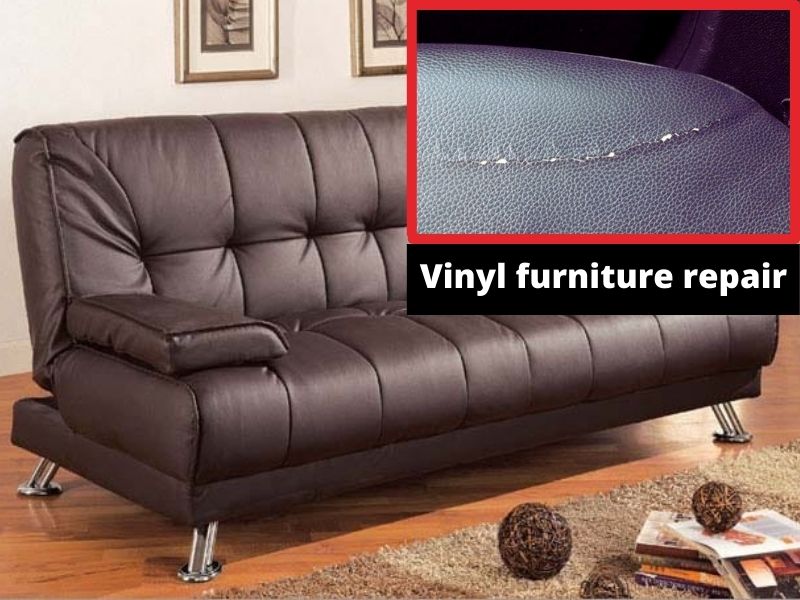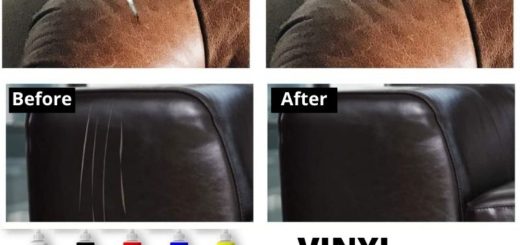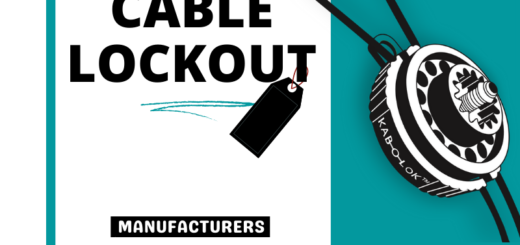How to Repair Vinyl Furniture – Vinyl Couch Repair Guide
Vinyl has come a long way since it was first launched in the 60s. Also known as “faux leather” or “fake leather.” vinyl is derived from polyvinylchloride (PVC) by adding special plasticizers to make the PVC flexible and suitable for use on furniture. Hard to soil or stain, vinyl remains a favorite for furniture; it is safe and relatively inexpensive. Vinyl allows manufacturers to provide an almost identical look and feel to genuine leather without inhumane practices and cruelty towards animals.
Vinyl is extensively used in creating stylish residential furniture and projects because it’s cheaper but offers the same rich, elegant, regal, and vintage look and feel of expensive leather. Seating in waiting rooms or restaurants, aircraft, and marine cabins and vehicles is made with vinyl due to its durability, cost, ease of cleanings, and availability in virtually any color, style, or pattern. Vinyl is easy to clean as it is naturally stain-resistant. You can wipe your vinyl furniture with a wet rag to clean. Vinyl also recycles well, making it less hazardous to the environment than other materials.
Vinyl is durable and lasts longer, but it gets damaged more easily than leather and sometimes becomes stained over time if not adequately treated.
It may get damaged from sharp objects such as keys, pocket knives, belt buckles, or pet scratching and incur a tear, gash, or cigarette burn. Vinyl is also vulnerable to cracking with age and exposure to harsh elements such as sunlight, solvents, abrasion, and sweat.
Repair Vinyl Furniture
If your vinyl furniture has suffered damage, you can try living with the damage for some time, repair the damage or purchase a new piece of furniture. While repairing vinyl furniture may seem daunting, especially if you have no experience, repairing a rip in vinyl furniture can be easily fixed at home.
When your vinyl seat develops a tear, it is best to deal with it as soon as possible. The longer you wait to repair a torn vinyl seat, the larger the damaged area will become.
Things to Use for Vinyl Repair
It is essential to repair a tear on your vinyl furniture as soon as possible to avoid it becoming more prominent. A complete newbie can quickly fix the most common problems and deteriorations of vinyl leather at home. All you need is a visit to the craft store, some vinyl adhesive, and a few minutes to repair.
Things Required to Repair Vinyl Furniture
- Cleaning Rag
- Sandpaper
- Iron
- Cotton swab
- Utility Scissors
- Vinyl patch
- Vinyl adhesive
- Colorant
- High Content Rubbing Alcohol (optional)
- Paper Towels
- Q-Tips
- Hairdryer (optional)
- Vinyl clear finish spray (optional)
Vinyl patches: These are additional vinyl pieces applied to the damaged area and efficiently cover any evidence of vinyl degradation.
See-through patches: These patches are similar to other pieces, except they are much thinner and see-through. These patches are primarily used to cover small holes quickly before they become more prominent.
You can also use a DIY vinyl repair kit to get the scratches from vinyl upholstery without paying a professional restorer. They are readily available on Amazon and come with cloths, repair compounds, and alcohol pads.

Steps to Repair Your Vinyl Furniture
Step 1
Trim the flaking pieces or any curling edges of the vinyl with fingers, a razor blade, or a cutter. Be careful not to cut off more than necessary. Clean the damaged area with rubbing alcohol or soapy cloth to remove dirt, body oils, and other contaminants. You can use a cotton swab, cotton pad, or Q-tip. Extend 1 or 2 inches past the damaged area so the repair material can easily stick. You can also use sandpaper to sand lightly over the cracked area of the damaged furniture, extending slightly past the damage to encourage adhesion.
Before using alcohol to rub on the vinyl, check if the rubbing alcohol removes the vinyl color by applying it to a small area.
Step 2
Find a piece of vinyl fabric with a matching color and texture as your furniture so that it doesn’t stand out. Vinyl fabric is available at a fabric or craft store. If you cannot find a matching fabric for your sofa, use white vinyl and dye it using a vinyl colorant. The vinyl colorant is cheap and readily available. Keep the patched area away from direct sunlight or high temperatures. Cut a large enough piece, approximately half an inch larger around the tear, to cover the incision. Be sure the edges are even.
Practice the color, and the repair techniques, on scrap vinyl before attempting to repair your vinyl furniture. Select a slightly darker shade than what is needed if you cannot obtain the color you wish.
Step 3
Use a spatula to apply a small bead of adhesive in an even, thin layer around the inside edge of the damaged area, extending slightly past the crack. Cover the entire perimeter with glue. You may need to apply multiple adhesive layers on the damaged piece until it is level with the surrounding area. Allow sufficient dry time between applying each layer. Wash and wipe the spatula between coat applications to avoid the hardened gummy buildup that may ruin your repair.
Step 4
Use a spatula to insert the backing fabric underneath the tear.
Place a finger in the hole and carefully smooth the fabric patch to perfectly flat under the spot. Create a gapless seal between the furniture fabric and the vinyl patch by pressing them together tightly. You can also use a graining paper containing a vinyl grain pattern, place it over the repaired area, and apply heated iron over the graining paper to emboss the pattern. Ensure that the backing fabric lies flat inside the damaged area as it acts as a replacement material for the vinyl, so you are not required to pull the vinyl together to cover the gap. Stuff the excess backing fabric under the undamaged vinyl. Wipe away any excess adhesive.
Step 5
While drying time depends on the thickness of the applied layer and the relative humidity of the environment, let the adhesive cure for approximately four hours. You can use a hairdryer to speed up the drying process. Do not use the repaired section of the furniture for at least 24 hours to allow the material to dry and settle ultimately.
Step 6
Buff and blend the repaired patch by using a Q-tip dipped in rubbing alcohol. Apply slight pressure to even out the edges. You can quickly get rid of the stickiness by curing the compound with rubbing alcohol to remove the stickiness and smoothen the repaired surface.
Tip
If you find deep holes in the damaged area, create a patch under the spot by using a piece of vinyl. You can insert the patch into the hole with the help of tweezers, and smooth the edges, and repair per the steps mentioned above.
Take a printed photograph of your couch before repairing it so that you can check for any noticeable differences.

Repairing Vinyl Furniture with Small Scratches
Tiny scratches that you cannot feel require only a colored dye/finish. Deeper scratches must be sanded and then dyed with enough layers to smooth out the finish. You might need to apply the dye in several sessions to get the best result.
How to Patch Large Holes in Your Vinyl Furniture
If you find a severe rip in your vinyl chair or sofa, you can still fix it before discarding them or calling for professional help.
Collect all the foam or other stuffing that has come out of the furniture and put it back inside. You need to pack as much lost fabric as possible or add a similar filling if it looks empty.
Mentally split the tear into sections. Following the steps highlighted above, start covering small areas of the incision, where each patch cover bits of the tear, becoming a lattice of patches. While this may appear messy initially, this is an ideal way to fix the hole on your own.
Once you have added all the patches and covered the hole completely, fill the area with dye filler; this will bind the pieces together and give it a smoother finish. Wait for the dye filler to dry, which may take around 6-8 hours. Once the hole is completely dry, use a cloth or sandpaper to buffer the area. Slowly and down the area until it has a smooth texture. Once you achieve the desired tone, apply another coat of dye to get it back to the correct color.
How to Preserve Vinyl Upholstery?
While vinyl may not be as durable as leather, it can last longer with proper care and maintenance.
You have to recondition vinyl furniture regularly, based on how often it is used. Vinyl furniture that is used daily should be refurbished annually. There are numerous vinyl and leather reconditioning kits available online with detailed instructions. Reconditioning encompasses covering your furniture with various finishes to keep it soft and nice to touch.
Avoid harmful products that contain silicone, ammonia, acids, bleach, dry cleaning solutions, petroleum, or household cleaners on your vinyl for cleaning, especially on dried-in spots. A highly acidic product can dull the sheen of the vinyl, as well as cause premature fading. Make a solution of warm water and mild dishwashing detergent and use it with a clean sponge. Dry the area quickly after cleaning with a clean towel, as too much water can damage the vinyl. Avoid using scouring pads, abrasives, and other rough materials.
Address surface spills on your vinyl furniture as soon as possible. Most often, soda, coffee, other liquids, and foods spillage can be easily wiped out with a damp cloth if it is done immediately. However, if the spillage dries out and settles on the furniture, it will need strenuous cleaning efforts to remove the residue of liquid or food spills.
Vacuum or dust the vinyl upholstery regularly as the dust settles in tiny spots in the furniture and may become a breeding spot for bacteria that produce unpleasant odors.
FAQs
How to Remove Scuff Marks out of Vinyl Furniture?
If you want to get rid of tiny scuff marks, you can use a pencil eraser. You can also use the one on the end of a pencil. Damp the eraser to rub out the scuff marks.
If the scuffs mark does not fade with the eraser, sprinkle the area with baking soda and leave it for a minute. Repeat the process with a wet sponge.
How to Clean Vinyl Upholstery?
Vinyl is easy to clean by simply wiping away the dirt without staining or damaging the fabric. Unlike leather that requires special cleaning agents to prevent possible damages, you can use everyday household products to clean vinyl. Wiping a damp cloth with a cleanser should be enough for cleaning vinyl daily.


Recent Comments